

Remembering Nazism: Nazi Propaganda. Nazi Germany - Propaganda. How did the Nazis use propaganda? - The Holocaust Explained Website. Goebbels sought to Nazify the whole of German culture, wiping away what Hitler saw as the ‘decadence’ of 1920s Weimar Germany, painting instead a picture of a Germany with traditional values and with Hitler as the beloved Führer.

The promotion of Nazi racial policy was at the very centre of Goebbels’s message. The re-writing of school books and the production of antisemitic books, films and exhibitions supported this policy. In 1929, Hitler chose Josef Goebbels as his Minister of Propaganda. Goebbels developed extremely successful campaigns using simple slogans and images repeated over and again in order to win public support for the party. The Nazis spent huge sums on newspapers, leaflets and poster campaigns. Art Under Fascism: Propaganda. Art was often was used as propaganda by the Nazi regime in Germany.

In general, art was a tool that the Nazi regime used to promote their beliefs or manipulate to fit their beliefs. In a way, all art was used as a form of propaganda. Propaganda in Nazi Germany. Propaganda within Nazi Germany was taken to a new and frequently perverse level.
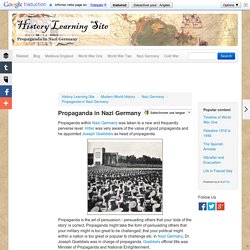
Hitler was very aware of the value of good propaganda and he appointed Joseph Goebbels as head of propaganda. Propaganda is the art of persuasion - persuading others that your 'side of the story' is correct. Joseph Goebbels. Joseph Goebbels, the son of Fritz Goebbels and Katharina Odenhausen, was born in Rheydt, Germany, on 29th October, 1897.

His father was a bookkeeper at the United Wick Factories. Joseph was the third son born to the couple. Teenage Pot Users Show Poor Long-Term Memory as Adults. Young adults who smoked marijuana every day for three years during their teen years have an oddly shaped hippocampus and performed poorly on long-term memory tasks, according to a new study published in Hippocampus this week.

A team led by Northwestern’s Matthew Smith used MRI to map the brains of 97 participants: 44 healthy controls, 10 subjects with a history of marijuana use disorder, 28 schizophrenia patients with no history of substance use disorders, and 15 schizophrenia patients with a marijuana use disorder. Participants with past cannabis use disorder were in their early twenties during the study and had stopped smoking pot for two years; they all started using marijuana daily when they were between 16 and 17 years old for about three years.
German art. German art has a long and distinguished tradition in the visual arts, from the earliest known work of figurative art to its current output of contemporary art.

Germany has only been united into a single state since the 19th century, and defining its borders has been a notoriously difficult and painful process. For earlier periods German art often effectively includes that produced in German-speaking regions including Austria, Alsace and much of Switzerland, as well as largely German-speaking cities or regions to the east of the modern German borders. Prehistory to Late Antiquity[edit] Venus of Hohle Fels, 35,000 to 40,000 BP, the oldest known figurative work of art (true height 6 cm (2.4 in)).
Pregnant Muslim woman attacked in Paris loses baby. Despite all medical efforts, a pregnant Muslim woman who was attacked by two Islamophobic men in the Paris suburb of Argenteuil on Thursday suffered a miscarriage and lost her baby, her lawyer said on Tuesday.
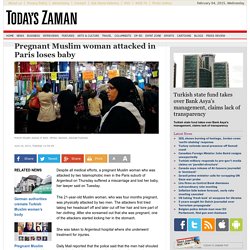
The 21-year-old Muslim woman, who was four months pregnant, was physically attacked by two men. The attackers first tried taking her headscarf off and later cut off her hair and tore part of her clothing. Timeline of the Russian Civil War 1918. CZECH LEGION ON A TRAIN IN SIBERIA Russian History 1918 Russian Civil War Timeline - Year 1918 January 10, 1918 (December 28, 1917 old style) The Cossacks declare their independence and form the Republic of the Don.
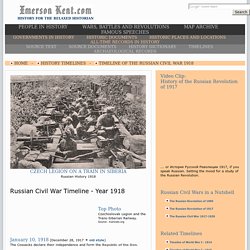
January 12, 1918 (December 30, 1917 old style) The Latvians declare their independence from Russia but find it hard to celebrate while occupying Germans are still sitting on their laps. January 18, 1918 (January 5, 1918 old style) The Constituent Assembly gathers. La première guerre mondiale (4) The Russian Revolution (1917–1918): Lenin and the Bolsheviks. Events April 3, 1917 Lenin arrives in Petrograd April 7 April Theses published in the newspaper Pravda April 21 First Bolshevik demonstrations Key People.
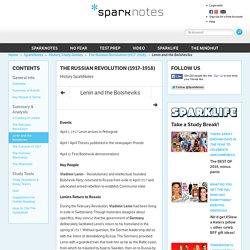
The Russian Revolution (1917–1918): The October Revolution. Events August 31, 1917 Bolsheviks achieve majority in the Petrograd Soviet September 5 Bolsheviks achieve majority in the Moscow Soviet October 10 Lenin and the Bolshevik Central Committee decide to proceed with revolution October 23 Provisional government acts to shut down all Bolshevik newspapers October 24 Provisional government deploys junkers Bolshevik troops begin to take over government buildings in the city.
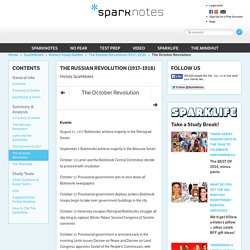
The Russian Revolution (1917–1918): The February Revolution. Events February 22, 1917 Nicholas II leaves Petrograd to visit troops February 23 International Women’s Day demonstration in Petrograd February 24 Massive strikes and demonstrations occur throughout the capital. W. Summary There were three reasons why Civil War broke out in Russia in 1918. The first reason was that the Bolsheviks had many enemies: These groups co-operated to try to bring down the Bolshevik government. A second cause was the Czech Legion – Czech prisoners of war who mutinied, took control of the Siberian Railway, and attacked towards Moscow. Finally, Britain, America and France, angry that Russia had dropped out of the First World War, attacked the Bolsheviks. Education.cambridge.org/media/577134/history_for_the_ib_diploma__causes__practices_and_effects_of_wars___cambridge_education___cambridge_samples.pdf. Austro-Serbian relations up to 1914. Austria-Hungary and Serbia hated each other.
The Fourteen Points. World War One - Causes. The first world war began in August 1914. It was directly triggered by the assassination of the Austrian archduke, Franz Ferdinand and his wife, on 28th June 1914 by Bosnian revolutionary, Gavrilo Princip. This event was, however, simply the trigger that set off declarations of war. The actual causes of the war are more complicated and are still debated by historians today. Alliances An alliance is an agreement made between two or more countries to give each other help if it is needed. A number of alliances had been signed by countries between the years 1879 and 1914. Imperialism Imperialism is when a country takes over new lands or countries and makes them subject to their rule. Militarism Militarism means that the army and military forces are given a high profile by the government. Nationalism. World War I for Kids: Fourteen Points.
Chronology 1918.
Fourteen Points - Woodrow Wilson - World War I. History of the Great War - Principal Events Timeline - 1918. Histoire et mémoire des deux guerres mondiales - Enseigner la première guerre mondiale - Les États-Unis et la 1ère guerre mondiale par Jean-Pierre Husson. WWI Timeline - 1914 to 1918. La guerre de 1914-1918 (Première Guerre mondiale) - Chronologie - f... 28 juin : assassinat de l’archiduc François-Ferdinand, héritier du trône d’Autriche-Hongrie.
L’attentat, perpétré à Sarajevo par de jeunes nationalistes serbes, s’inscrit dans le contexte politique très tendu des Balkans. Les peuples slaves, soutenus par la Russie, s’opposent à la domination austro- hongroise. En représailles à ce meurtre, Vienne adresse un ultimatum à la Serbie le 23 juillet et lui déclare la guerre le 28. 3 août : l’Allemagne déclare la guerre à la France. En quelques jours, le jeu des alliances plonge presque toute l’Europe dans la guerre. Les forces en présence La Triple Alliance est conclue en 1882 entre l’Allemagne, l’Autriche- Hongrie et l’Italie. 1914 : Empire Ottoman 1915 : Bulgarie La Triple Entente se construit entre 1893 et 1907 et réunit la France, la Russie et l’Angleterre. 1914 : Serbie, Belgique et Japon Italie Roumanie et Portugal Grèce et Etats-Unis.